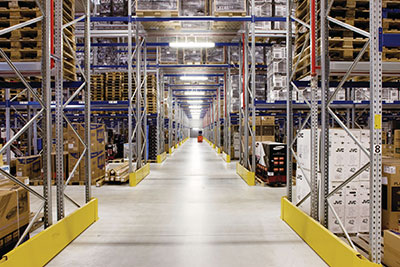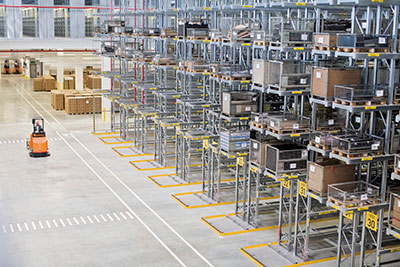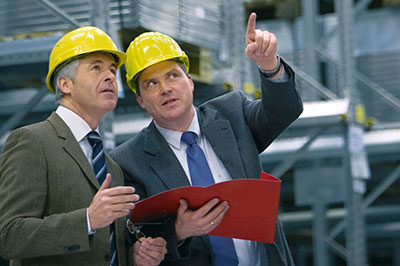 Simply buying pallet racking and having it professionally installed isn’t the end of your commitment. As with anything, pallet racking can be subject to wear and tear and unless you look after it, you could be compromising the safety of your workforce and the smooth running of your operation.
Simply buying pallet racking and having it professionally installed isn’t the end of your commitment. As with anything, pallet racking can be subject to wear and tear and unless you look after it, you could be compromising the safety of your workforce and the smooth running of your operation.
Pallet racking is a highly engineered system of uprights and beams, which must be installed and maintained correctly. Damage to the uprights, or bolts coming loose that go unnoticed, could store up trouble. You may even find your pallet racking collapses and you then have to replace the equipment altogether – all avoidable, had it been properly maintained.
So here are some steps you can take to ensure the ongoing maintenance of your adjustable pallet racking, while also looking after the safety of your workforce.
1. Have your pallet racking inspected
 We would advise engaging the services of a reputable inspector who will ensure your pallet racking meets the relevant international and national standards that apply, in terms of installation and health and safety.
We would advise engaging the services of a reputable inspector who will ensure your pallet racking meets the relevant international and national standards that apply, in terms of installation and health and safety.
Specifically, an inspection be able to:
- identify any unsafe components
- highlight potential risk areas for the pallet racking (for example, where there is high forklift truck activity)
- pinpoint any risk areas for personnel.
If any concerns or issues are uncovered, do ensure rectification is carried out to industry standards.
2. Increase safety with paint technology
 The strategic application of paint to the floor, walls and ceiling of a warehouse facility can greatly enhance safety, so protecting both your pallet racking and your workforce.
The strategic application of paint to the floor, walls and ceiling of a warehouse facility can greatly enhance safety, so protecting both your pallet racking and your workforce.
Brightly painted zones, lines and hazard symbols draw warehouse workers’ attention. Floor markings can be used to indicate safe pedestrian walkways and aisles. They could even be used to indicated ‘roadways’ for forklifts to travel along, to help avoid collision with each other and with the pallet racking.
Paint can be used in different areas, in different colours, to indicate specific zones. Non-slip flooring will also help increase the levels of safety for staff.
3. Adopt best practice in your warehouse
To ensure the optimum safety of your workforce and the most efficient running of your warehouse, it is advisable to draw up a Code of Conduct which follows best practice.
 This will apply to everyone who enters the warehouse, workers and visitors included, and if followed, will greatly reduce any risks to the pallet racking and to people.
This will apply to everyone who enters the warehouse, workers and visitors included, and if followed, will greatly reduce any risks to the pallet racking and to people.
Before entering the warehouse, people must be made familiar with the Code and it also needs to be displayed in prominent places, as a reminder.
You can include in the Code rules governing a range of safety areas. For example, you may want people to wear hard hats or high vis vests; you may have rules governing lighting levels in different locations.
Finally, the Code must include information about penalties taken if they are contravened. This will help you with reinforcement.
4. Inspect and maintain mechanical lifting equipment
Your pallet racking will come into contact with other equipment, such as hoists or forklifts. It is just as important that these are maintained and kept in good working order. Regular inspections, with any faulty parts repaired or replaced, will maximise the safety of your pallet racking and your workforce.
5. Carry out regular inspections
 It should be part of your protocol as a business to carry out regular inspections of your pallet racking – don’t just wait for an annual inspection by a professional.
It should be part of your protocol as a business to carry out regular inspections of your pallet racking – don’t just wait for an annual inspection by a professional.
You could carry out a weekly, or even daily, visual check and ensure this is tasked to a specific person or team. The inspections should be logged and the results recorded.
These inspections are important evidence that you are carrying out due diligence on your pallet racking. More importantly, any problems – such as loose bolts or buckled uprights – will be reported and then rectified.
Your reporting system could incorporate colour coding for issues spotted: red problems need immediate attention; amber need attention within a set timeframe etc.
6. Introduce a reporting culture
 If one of your team damages the pallet racking – perhaps they knock it with a forklift truck – are they prepared to report it? Or are they fearful of the repercussions? It is vital that you have a culture in your warehouse that encourages and enables staff to report any mishaps or accidents. Otherwise, damage may go unreported with serious consequences.
If one of your team damages the pallet racking – perhaps they knock it with a forklift truck – are they prepared to report it? Or are they fearful of the repercussions? It is vital that you have a culture in your warehouse that encourages and enables staff to report any mishaps or accidents. Otherwise, damage may go unreported with serious consequences.
By following these simple guidelines and investing in a quality pallet racking solution, you are ensuring the safety of your staff and the continuity of your business. You will also be protecting your investment.
For more advice on adjustable pallet racking solutions, installation and safety, please get in touch.